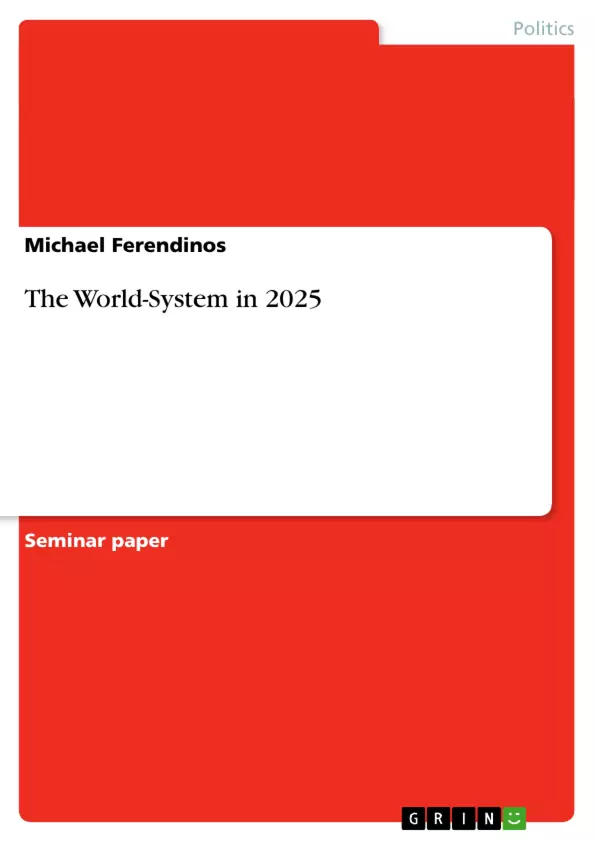The primary aim of this paper is to provide a detailed analysis of the manner in which important current trends will shape the future of the division of labour and the world system as a whole. The implications of the major political (loss of sovereignty), technological, cultural (globalisation vs. identity), environmental (population growth) and economic trends that the current generation faces will be considered; thereafter looking at its impact on the global division of labour.
This will be followed by a thorough analysis of what the nature and structure of the world system will look like in 2025. The paper will end off with a prediction of what the balance of power in the system will be around this time, looking at several candidates for possible hegemony.
The argument posed in this essay is that the world system is undergoing a transitional phase, whereby the system could potentially collapse and be replaced by another one, although this is not likely to occur as early as 2025. The other argument is that the ushering in of a new hegemon is a lengthy process, one that will probably not have taken root by this time; thus 2025 will almost certainly be characterized by a multipolar system.
[...]
Inhaltsverzeichnis (Table of Contents)
- 1. Introduction
- 2. Division of Labour in the World System
- 3. Trends
- A) The loss of sovereignty
- 1a) Multilateralism
- 2a) International Institutions and Regional Blocs
- 3a) Loss of Monopoly on Violence
- 4a) Impact on Division of Labour
- B) Trends in knowledge and technology
- 1b) Military Technology
- 2b) The Network Society
- 3b) Intellectual Property Rights
- 4b) Impact on Division of Labour
- C) Globalisation vs Identity
- 1c) Nationalism
- 2c) Tribalism
- 3c) Impact on Division of Labour
- D) Growing population
- 1d) Urbanization
- 2d) Water Wars
- 3d) New Epidemics
- 4d) Impact on Division of Labour
- E) The Changing Economy
- 1e) The Rise of China and India
- 2e) A Revolt against Neoliberalism
- 3e) An Ageing Population
- 4e) Rising Inequality
- 5e) Impact on Division of Labour
- A) The loss of sovereignty
- 4. Structure of World System in 2025
- a) A System in Crisis?
- 5. Hegemony in the World System
- a) The Concept of Hegemony
- b) The Theory of Hegemonic Stability
- c) Will 2025 usher in a new hegemon?
- 6. The United States
- 7. China
- a) Economic Growth
- b) Military Growth
- c) Will China emerge on top by 2025?
- 8. India
- 9. Japan
- 10. The European Union
- 11. A Multipolar system
Zielsetzung und Themenschwerpunkte (Objectives and Key Themes)
This paper aims to analyze how current trends will shape the future of the division of labor and the world system by 2025. It examines the implications of major political, technological, cultural, environmental, and economic trends on the global division of labor, predicting the structure and balance of power in the world system at that time. The paper argues that the world system is in a transitional phase, and considers the likelihood of systemic collapse or the emergence of a new hegemon.
- The impact of current trends on the division of labor.
- The future structure of the world system in 2025.
- The potential emergence of a new global hegemon.
- The loss of state sovereignty in the face of globalization.
- The interplay between globalization and national/cultural identities.
Zusammenfassung der Kapitel (Chapter Summaries)
Chapter 1: Introduction introduces the paper's objective: to analyze how current trends will impact the division of labor and the world system by 2025. It presents the core argument: the world system is in transition, with the possibility of systemic change, but not necessarily a new hegemon by 2025.
Chapter 2: Division of Labour in the World System describes the core, semi-peripheral, and peripheral zones within the world system, explaining their interactions and the dynamics of exploitation.
Chapter 3: Trends explores several significant trends: the loss of state sovereignty due to globalization and the rise of multilateralism and supranational institutions; technological advancements and their impact; the tension between globalization and national/cultural identities; and the effects of population growth and economic shifts.
Schlüsselwörter (Keywords)
World-system, division of labor, globalization, state sovereignty, multilateralism, hegemony, technological change, nationalism, population growth, economic inequality, China, India, United States.
- Citar trabajo
- M.A. Michael Ferendinos (Autor), 2007, The World-System in 2025, Múnich, GRIN Verlag, https://www.grin.com/document/122894



